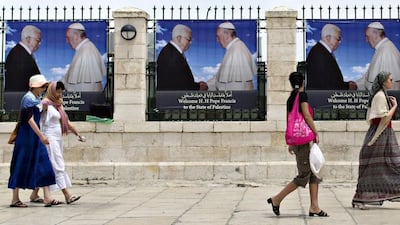AMMAN // Jordan is hoping the visit of Pope Francis on Saturday will boost the kingdom’s flagging religious tourism industry in a country that has one of the region’s most significant pilgrimage sites.
The 77-year-old pontiff will start his three-day tour of the Holy Land by meeting King Abdullah II and Queen Rania before celebrating mass at Amman’s international stadium.
The Argentinian’s trip to Jordan is spiritual and humanitarian in nature. He will be meeting with orphans, those with disabilities and others struggling with illness, as well as Syrian and Iraqi refugees forced to flee their homes.
In the evening he will head to Bethany Beyond the Jordan, the site in the Jordan Valley where Jesus is said to have been baptised.
The Pope will leave Amman on Sunday morning and will be flown by helicopter to Bethlehem in the West Bank, where he will celebrate mass in Manger Square, before heading to Israel in the evening.
The late Pope John Paul II, who visited Jordan in 2000 in the first papal tour of the country since 1964, recognised Bethany Beyond the Jordan as the site where Jesus was baptised, denying Israeli claims the baptism took place in its territory.
Underscoring the significance of that decision, Pope Benedict XVI also visited the site in 2009, as part of his pilgrimage to the region.
But despite the Vatican’s recognition, the number of religious tourists in Jordan has dropped significantly in recent years, as the global financial crisis and regional turmoil dealt a blow to the Middle East’s travel sector.
While Jordan is pleased to have the various refugee crises highlighted — the kingdom is dependent on UN aid to meet the costs of hosting hundreds of thousands of displaced people — it is nonetheless firmly focused on the opportunity to market the country to Christian pilgrims, including the world’s 1.6 billion Catholics.
“The pope’s visit, spiritual, humanitarian, comes at a critical time in the region. We are in a hot zone,” said Dia Madani, director of the Baptism Site commission.
“He is not here to market Jordan’s religious sites. Still, it is the spiritual aspect of the visit which we bank on. He comes here as a pilgrim, starting with the baptism site. It is a tradition for Catholics to follow the footsteps of the Pope.”
Ahead of the visit, workers are toiling round the clock at Bethany Beyond the Jordan, hanging photos of the Pope and installing lighting for an evening mass on Saturday.
A special passage has been created to enable him to reach the Jordan River.
Posters showing King Abdullah greeting the Pope have also been hung in the capital, Amman, and on the road to the baptism site, north of the Dead Sea.
The site was once a military zone but in 1997, three years after Jordan and Israel signed a peace treaty, the area was demined and, in 2002, opened to the public.
In 2010, the site had its peak number of tourists, with 250,000 pilgrims visiting but in the last two years, the number of tourists has dropped.
Many tourists come to the region on package tours that take in other nations and have put their plans on the back burner because of the war in Syria.
In 2013, the number of tourists had dropped to just 86,300 visiting the baptism site, the vast majority, 39,000, from Europe.
“We are hoping there will be more business,” said Simon Al Shoumali, a partner at Saint John The Baptist Store, that sells religious items from icons to charms at the site.
“Traffic was fair but it could be better. Because of the regional circumstances, the business has slowed down by 20 per cent. But now we started noticing Italians coming here for the Pope’s visit.”
Since excavations began in 1996, 11 churches, caves and baptism pools dating to the Roman and Byzantine period were uncovered in Jordan.
“We are hoping to reach the benchmark of a million visitors annually,” Mr Dia, the Baptism site director, said. But he acknowledged it will not be an easy task with high prices of air fares to the country, taxes and a limited budget for Jordan’s Tourism Board, the promotional arm of the tourism ministry, to market the country abroad.
The Baptism site is currently undergoing a major development plan that entails constructing 13 churches and monasteries. “More than half are already built,” Mr Dia said. “We want to rewrite history and to turn it into a Christian pilgrimage site.”
foreign.desk@thenational.ae

